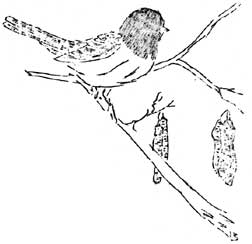
Among the alders that grow along the edge of the Nisqually River bar
we hear at this time the melodious tinkle which is the song of the
Junco. A sure sign of spring--the song of the Junco--but he lives not
for song alone. The alders along the Nisqually are heavily hung with
loose catkins, and as if rejoicing in this season's abundance he pauses
occasionally in his foraging to sit upon the tip of some snag or tree
top to pour forth a welcome to the warm, radiant sunshine that bathes
the earth at this season. Accompanied by the bass rumble of the river
nearby, it makes a pleasing duet.
|
 |
The first robin to return to the park--as you will probably remember
from the March issue of Nature Notes--was noted on Feb. 2. Now we see
numerous of this early bird's relatives and their familiar "chirr-up" as
these early spring days draw to a close is needless to say, a pleasant
song to hear. With the robins may also be seen numerous Varied
Thrushes--a bird which, while present in the park throughout the entire
year, is most noticeable at this season due to its melodious two-toned
song. Occasionally we hear the bubbling song of the Western Wren along
the shaded forest trails of the lower elevations--a song that is
coincident with the bursting of the buds on our trees, for this bird has
been characterized by a mouse-like furtiveness during the months just
past.
And strangely we have failed to note the presence of woodpeckers in
the park this winter. The striking red and black of the Pileated
Woodpecker's plumage was conspicuous by its absence and the diminutive
Downy, which we see occasionally exploring the bark of trees, apparently
was among the missing. Even the Harris Woodpecker, our old "standby"
among the woodpecker clan during the winter months, was not noted until
March 10th when its sharp call was noted for the first time. Also on
March 10, a large flock of Crossbills were foraging among the cones of
the Red Cedars in the vicinity of Longmire. Swirling about high in the
trees almost like a swarm of bees their nervous pitched notes attracted
considerable attention.
And so we find our birds entering upon another seasonal cycle of
activity. Some of the feathered winter residents show signs of taking
up housekeeping again and the vanguard of the summer clan is
returning.

